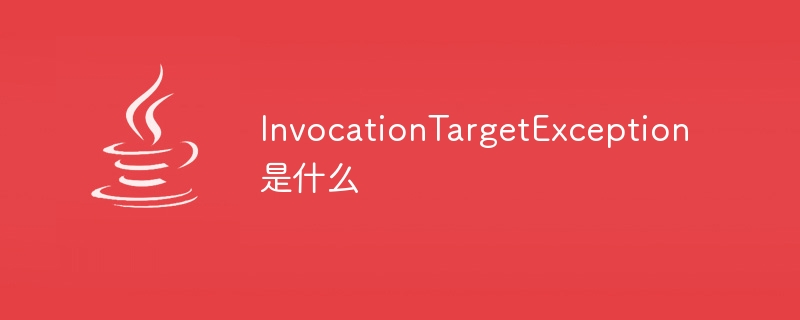What is InvocationTargetException
InvocationTargetException is an exception class in the Java programming language, used to represent exceptions that occur during method invocation. When using the reflection mechanism to call a method or constructor, if the called method or constructor itself throws an exception, but the code segment that calls the invoke() method does not catch the exception, the invoke() method will encapsulate the exception. in an InvocationTargetException and throw it.

InvocationTargetException is an exception class in the Java programming language, used to represent exceptions that occur during method invocation. It is thrown by the Method class in the java.lang.reflect package and the invoke() method in the Constructor class and is used to call other methods or constructors.
When using the reflection mechanism to call a method or constructor, if the called method or constructor itself throws an exception, but the code segment that calls the invoke() method does not catch the exception, then invoke() The method will encapsulate this exception in an InvocationTargetException and throw it.
InvocationTargetException is a checked exception that inherits from the ReflectiveOperationException class in the java.lang.reflect package, which inherits from the java.lang.Exception class. This means that when writing code, we must handle or declare the exception explicitly.
InvocationTargetException contains a cause attribute, which indicates the cause of the exception thrown by calling the target method or constructor. By calling the getCause() method of InvocationTargetException, we can obtain the original exception and further analyze and process it.
Usually, when using reflection to call a method or constructor, if the target function throws a checked exception, we can handle this exception by catching InvocationTargetException. After catching the InvocationTargetException, we can get the actual exception by calling the getCause() method, and handle it accordingly according to the specific business logic.
The following is an example that shows how to use InvocationTargetException to handle exceptions:
try {
// 获取目标方法
Method method = MyClass.class.getMethod("myMethod");
// 调用目标方法
method.invoke(new MyClass());
} catch (InvocationTargetException e) {
// 获取原始异常
Throwable cause = e.getCause();
// 根据实际业务逻辑处理异常
if (cause instanceof MyException) {
// 处理MyException异常
} else {
// 处理其他异常
}
} catch (NoSuchMethodException | IllegalAccessException e) {
// 处理其他异常
}In the above example, if the target method myMethod throws a MyException exception, then when the invoke() method is called , InvocationTargetException will encapsulate this exception and throw it. We can get the original MyException exception by catching InvocationTargetException and calling the getCause() method, and handle it according to the actual business logic.
Summary
InvocationTargetException is an exception class used to represent an exception that occurs when a method or constructor is called reflectively. It encapsulates exceptions thrown by target methods or constructors and provides a mechanism to handle these exceptions.
The above is the detailed content of What is InvocationTargetException. For more information, please follow other related articles on the PHP Chinese website!

Hot AI Tools

Undresser.AI Undress
AI-powered app for creating realistic nude photos

AI Clothes Remover
Online AI tool for removing clothes from photos.

Undress AI Tool
Undress images for free

Clothoff.io
AI clothes remover

AI Hentai Generator
Generate AI Hentai for free.

Hot Article

Hot Tools

Notepad++7.3.1
Easy-to-use and free code editor

SublimeText3 Chinese version
Chinese version, very easy to use

Zend Studio 13.0.1
Powerful PHP integrated development environment

Dreamweaver CS6
Visual web development tools

SublimeText3 Mac version
God-level code editing software (SublimeText3)

Hot Topics
 1378
1378
 52
52
 How does Java's classloading mechanism work, including different classloaders and their delegation models?
Mar 17, 2025 pm 05:35 PM
How does Java's classloading mechanism work, including different classloaders and their delegation models?
Mar 17, 2025 pm 05:35 PM
Java's classloading involves loading, linking, and initializing classes using a hierarchical system with Bootstrap, Extension, and Application classloaders. The parent delegation model ensures core classes are loaded first, affecting custom class loa
 How do I implement multi-level caching in Java applications using libraries like Caffeine or Guava Cache?
Mar 17, 2025 pm 05:44 PM
How do I implement multi-level caching in Java applications using libraries like Caffeine or Guava Cache?
Mar 17, 2025 pm 05:44 PM
The article discusses implementing multi-level caching in Java using Caffeine and Guava Cache to enhance application performance. It covers setup, integration, and performance benefits, along with configuration and eviction policy management best pra
 How can I use JPA (Java Persistence API) for object-relational mapping with advanced features like caching and lazy loading?
Mar 17, 2025 pm 05:43 PM
How can I use JPA (Java Persistence API) for object-relational mapping with advanced features like caching and lazy loading?
Mar 17, 2025 pm 05:43 PM
The article discusses using JPA for object-relational mapping with advanced features like caching and lazy loading. It covers setup, entity mapping, and best practices for optimizing performance while highlighting potential pitfalls.[159 characters]
 How do I use Maven or Gradle for advanced Java project management, build automation, and dependency resolution?
Mar 17, 2025 pm 05:46 PM
How do I use Maven or Gradle for advanced Java project management, build automation, and dependency resolution?
Mar 17, 2025 pm 05:46 PM
The article discusses using Maven and Gradle for Java project management, build automation, and dependency resolution, comparing their approaches and optimization strategies.
 How do I create and use custom Java libraries (JAR files) with proper versioning and dependency management?
Mar 17, 2025 pm 05:45 PM
How do I create and use custom Java libraries (JAR files) with proper versioning and dependency management?
Mar 17, 2025 pm 05:45 PM
The article discusses creating and using custom Java libraries (JAR files) with proper versioning and dependency management, using tools like Maven and Gradle.




